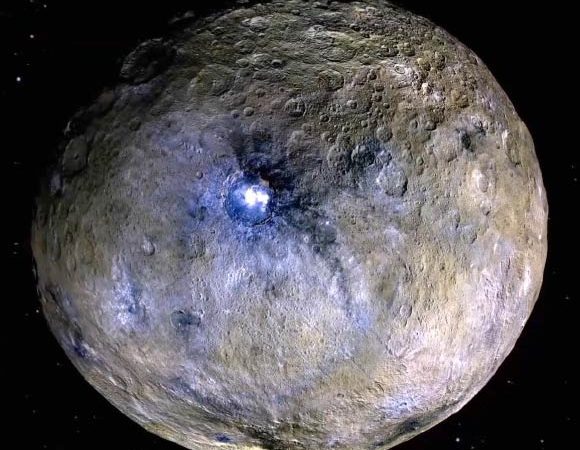NASA’s Dawn spacecraft has detected recent changes in Ceres’ surface, revealing that the dwarf planet is a dynamic planetary body that continues to evolve and change. The results are published in two papers in the journal Science Advances.
One of the two new studies revealed the abundance of ice on the northern wall of Juling Crater, a 12-mile (20 km) crater in the southern hemisphere of Ceres.
The new observations, made by Dawn’s Visual and Infrared Imaging Spectrometer (VIR) instrument from April to October 2016, show an increase in the amount of ice on the crater wall.
“This is the first direct detection of change on the surface of Ceres,” said Dr. Andrea Raponi, a researcher at the Institute of Astrophysics and Planetary Science, Italy.
“The combination of Ceres moving closer to the Sun in its orbit, along with seasonal change, triggers the release of water vapor from the subsurface, which then condenses on the cold crater wall. This causes an increase in the amount of exposed ice.”
“The warming might also cause landslides on the crater walls that expose fresh ice patches.”
Previous data had shown Ceres has a crust about 25 miles (40 km) thick and rich in water, salts and, possibly, organics.

This view from NASA’s Dawn orbiter shows where water ice has been detected in the northern wall of Ceres’ Juling Crater. Dawn acquired the picture with its framing camera on August 30, 2016. Image credit: NASA / JPL-Caltech / UCLA / MPS / DLR / IDA / ASI / INAF.
In the second study, Dawn/VIR observations also reveal new information about the variability of Ceres’ crust, and suggest recent surface changes, in the form of newly exposed material.
Dawn previously found carbonates — common on the dwarf planet’s surface — that formed within a global ocean.
Sodium carbonates, for example, dominate the bright regions in Occator Crater, and material of similar composition has been found at Oxo Crater and Ahuna Mons.
Study lead author Giacomo Carrozzo, also from the Institute of Astrophysics and Planetary Science, and colleagues identified 12 sites rich in sodium carbonates and examined in detail several areas of a few square miles that show where water is present as part of the carbonate structure.
This study marks the first time hydrated carbonate has been found on the surface of Ceres, or any other planetary body besides Earth, giving us new information about the dwarf planet’s chemical evolution.
Water ice is not stable on the surface of Ceres over long time periods unless it is hidden in shadows, as in the case of Juling. Similarly, hydrated carbonate would dehydrate, although over a longer timescale of a few million years.
“This implies that the sites rich in hydrated carbonates have been exposed due to recent activity on the surface,” Dr. Carrozzo said.

This view from Dawn shows Ceres’ tallest mountain, Ahuna Mons, 2.5 miles (4 km) high and 11 miles (17 km) wide. This is one of the few sites on Ceres at which a significant amount of sodium carbonate has been found, shown in green and red colors in the lower right image. The top and lower left images were collected by Dawn’s framing camera. The top image is a 3D view reconstructed with the help of topography data. Image credit: NASA / JPL-Caltech / UCLA / MPS / DLR / IDA / ASI / INAF.
The great diversity of material, ice and carbonates, exposed via impacts, landslides and cryovolcanism suggests Ceres’ crust is not uniform in composition.
These heterogeneities were either produced during the freezing of Ceres’ original ocean — which formed the crust — or later on as a consequence of large impacts or cryovolcanic intrusions.
“Changes in the abundance of water ice on a short timescale, as well as the presence of hydrated sodium carbonates, are further evidence that Ceres is a geologically and chemically active body,” said Dr. Cristina De Sanctis, VIR team leader at the Institute of Astrophysics and Planetary Science.
Source: Sci News

































Leave a Comment
You must be logged in to post a comment.